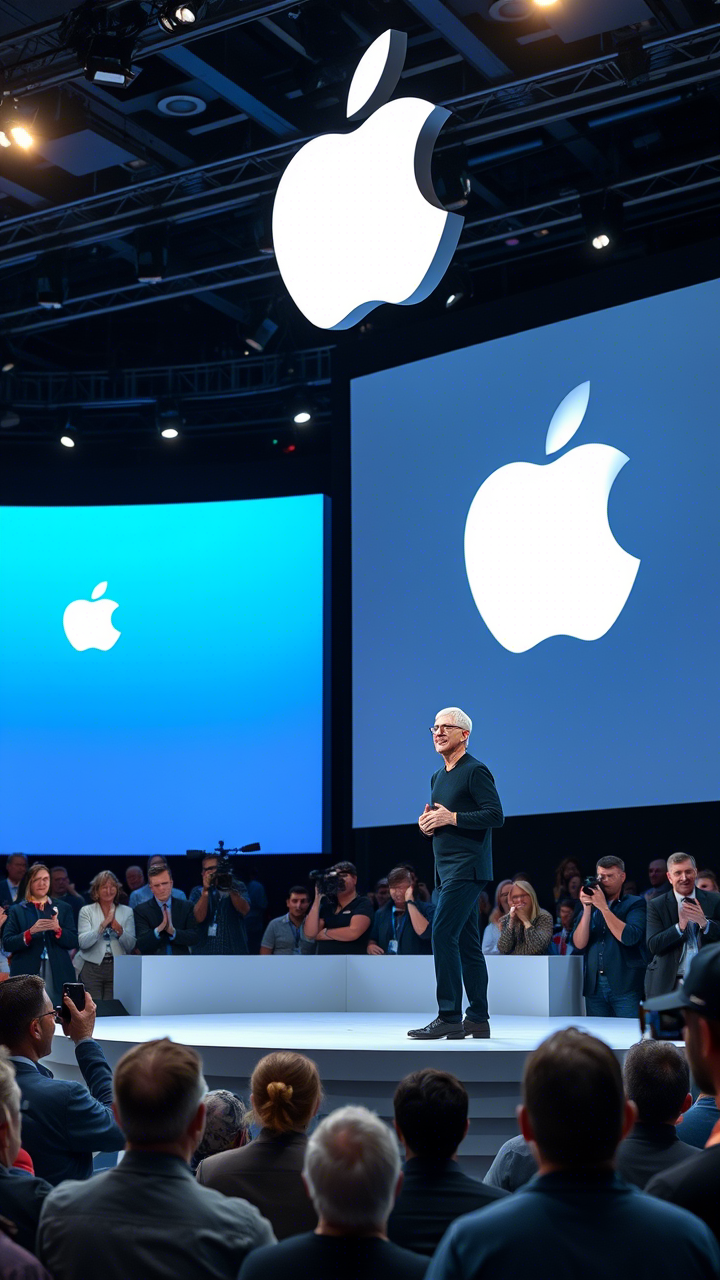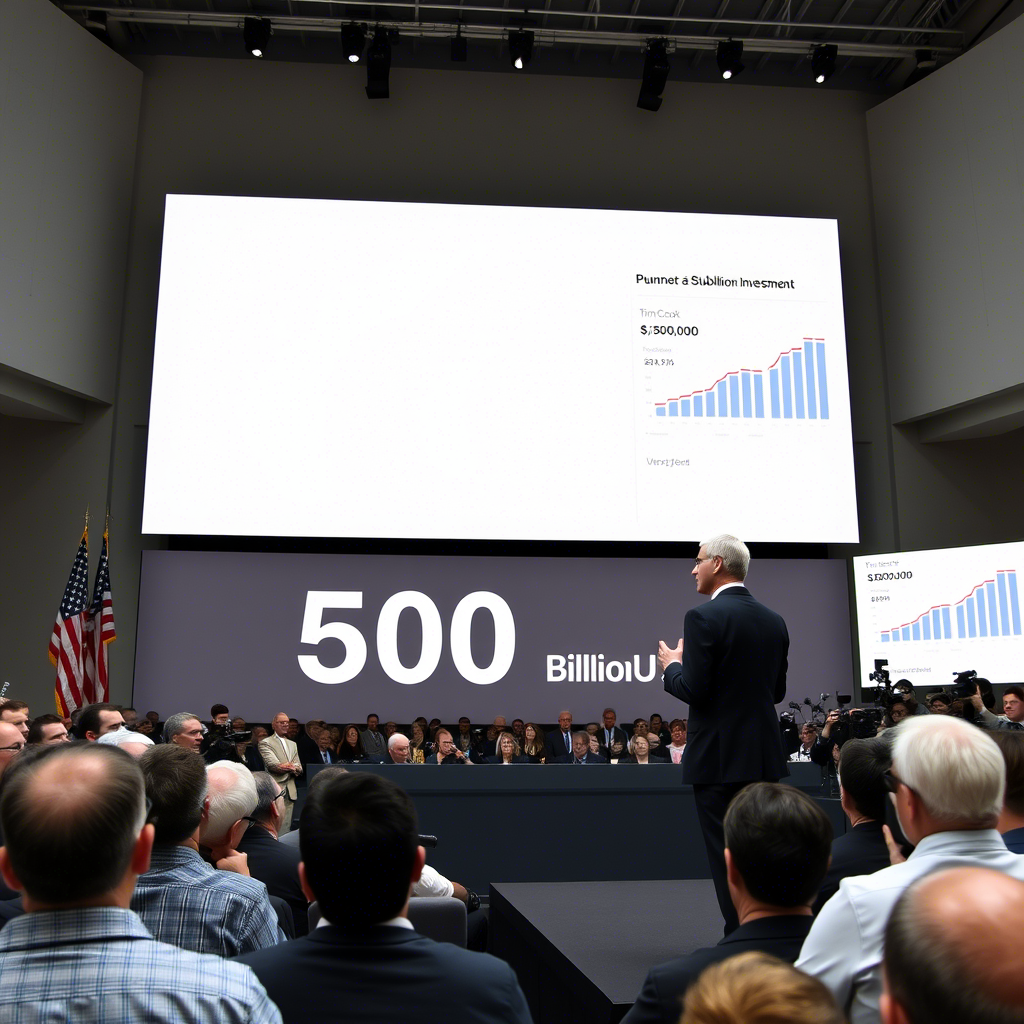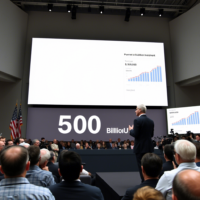In a bold move that underscores its commitment to American economic growth, technological advancement, and job creation, Apple has announced an unprecedented $500 billion investment in U.S. manufacturing and innovation over the next decade. The tech giant’s announcement reflects not only its confidence in the resilience of the U.S. economy but also its role as a leader in driving global innovation. This historic initiative aligns with Apple’s long-standing vision to create lasting value for communities while advancing cutting-edge technologies.

A Bold Vision for America’s Future
Apple’s $500 billion commitment is more than just a financial pledge; it represents a comprehensive strategy to bolster the U.S. economy through investments in advanced manufacturing, research and development (R&D), and workforce development. At the heart of this initiative lies a firm belief in the potential of American ingenuity to shape the future of technology. Tim Cook, Apple’s CEO, emphasized this sentiment during the announcement, stating, “We are bullish on the future of America and its ability to lead the world in innovation.”
The investment plan builds upon Apple’s previous commitments, which have already generated significant positive impacts across the country. Since 2018, Apple has invested over $350 billion in the U.S., creating hundreds of thousands of jobs and supporting suppliers nationwide. With this new announcement, Apple aims to amplify these efforts by expanding its reach into key industries such as semiconductor manufacturing, renewable energy, artificial intelligence (AI), and quantum computing.
Driving Advanced Manufacturing Leadership
One of the most notable aspects of Apple’s $500 billion investment is its focus on strengthening the U.S.’s position as a global leader in advanced manufacturing. Over the past few years, there has been growing concern about the nation’s reliance on foreign supply chains for critical components like semiconductors. Recognizing this challenge, Apple plans to invest heavily in domestic semiconductor production, partnering with leading manufacturers to ensure a stable and secure supply chain.
This effort will include collaborations with companies at the forefront of chip design and fabrication, enabling them to scale operations and meet increasing demand from various sectors, including automotive, healthcare, and telecommunications. By fostering partnerships between private industry and academia, Apple hopes to accelerate breakthroughs in materials science, automation, and robotics—all essential elements of modern manufacturing.
Furthermore, Apple intends to expand its network of supplier facilities across the United States, bringing high-paying jobs to regions traditionally underserved by tech giants. These expansions will focus on states where opportunities exist to leverage local talent pools and infrastructure, ensuring equitable distribution of benefits derived from this massive investment.
Fueling Innovation Through Research & Development
Research and development form another cornerstone of Apple’s ambitious plan. As part of the $500 billion allocation, substantial funds will be directed toward advancing core technologies that define the company’s product portfolio, including AI, machine learning, augmented reality (AR), and beyond. Investments in these areas aim to push boundaries further, offering users experiences previously unimaginable while maintaining Apple’s reputation for excellence in user experience and privacy protection.

Additionally, Apple will continue investing in environmental sustainability initiatives, building on its goal to achieve carbon neutrality across its entire business by 2030. Funds earmarked for green technologies will support projects aimed at reducing emissions throughout the lifecycle of Apple products—from raw material extraction to end-of-life recycling. For example, innovations in battery chemistry could result in longer-lasting devices powered by cleaner energy sources, contributing positively both economically and ecologically.
Collaboration with universities and research institutions plays a vital role in driving progress within these fields. Apple envisions establishing joint ventures focused on solving complex problems related to emerging technologies, thereby nurturing young minds capable of tackling tomorrow’s challenges head-on.
Empowering Workforce Development
To fully realize the potential of its massive investment, Apple recognizes the importance of equipping workers with skills necessary to thrive in today’s rapidly evolving digital landscape. Therefore, a portion of the $500 billion will go towards enhancing educational programs designed to prepare individuals for careers in STEM (Science, Technology, Engineering, Mathematics) disciplines.
Through partnerships with community colleges, vocational schools, and four-year universities, Apple seeks to democratize access to quality education regardless of socioeconomic background. Programs may range from coding boot camps targeting underrepresented groups to advanced degree offerings aligned closely with industry needs. Moreover, apprenticeship models emphasizing hands-on learning combined with theoretical knowledge promise to bridge gaps between classroom theory and real-world application effectively.
Beyond formal education, continuous professional development remains crucial for retaining top talent amidst fierce competition among tech firms. Consequently, Apple plans to offer extensive training resources internally, empowering employees to grow alongside their roles as technology evolves. Such measures demonstrate Apple’s dedication not merely to hiring skilled labor but cultivating lifelong learners committed to excellence.
Economic Impact Across the Nation
While Silicon Valley often dominates discussions surrounding tech employment, Apple’s latest announcement highlights its intent to spread prosperity far beyond coastal hubs. Rural areas and smaller cities stand poised to benefit significantly from increased manufacturing activity spurred by this investment. New factories mean new jobs, attracting families seeking stability and opportunity outside bustling metropolitan centers.
Moreover, ancillary businesses catering to newly established operations—such as logistics providers, maintenance contractors, or retail establishments—will experience growth spurts commensurate with rising demand. Local governments might even see improved tax revenues allowing reinvestment back into public services benefiting all residents.
By diversifying geographical footprints strategically, Apple helps mitigate risks associated with concentrating too much economic activity within specific locales. Simultaneously, they contribute meaningfully toward narrowing regional disparities exacerbated by uneven recoveries following recent crises.
Conclusion: Leading With Purpose
Apple’s unveiling of a $500 billion investment in U.S. manufacturing and innovation signifies far more than corporate largesse—it embodies purposeful leadership aimed at shaping a brighter future for everyone involved. From fortifying national security via robust domestic supply chains to inspiring next-generation innovators through targeted educational outreach, each component of this grand initiative reinforces Apple’s status as a responsible corporate citizen dedicated to making meaningful contributions wherever possible.
As we look ahead, one thing becomes abundantly clear: With trailblazers like Apple championing causes aligned so closely with societal well-being, there’s every reason to share their optimism regarding what lies ahead for America—and indeed, the world. After all, when leaders step up boldly, others tend to follow suit, amplifying positive change exponentially. And who wouldn’t want to be part of that story?

